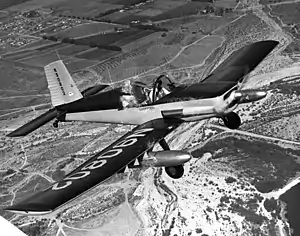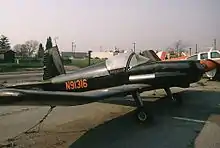Fletcher FD-25
The Fletcher FD-25 Defender was a light ground-attack aircraft developed in the United States in the early 1950s.
| FD-25 Defender | |
|---|---|
 | |
| Role | Counterinsurgency aircraft |
| Manufacturer | Fletcher |
| Designer | John Thorp |
| First flight | 1953 |
| Primary users | Royal Cambodian Air Force Republic of Vietnam Air Force |
| Number built | 13 |
Design and development
Designed by John Thorp, the Defender was a conventional low-wing cantilever monoplane with fixed tailwheel undercarriage. Provision was made for two machine guns in the wings, plus disposable stores carried on underwing pylons. Construction throughout was all-metal, and the pilot sat under a wide perspex canopy.
Operational history
Three prototypes were built, two single-seaters and a two-seater, but no orders were placed by the US military. In Japan, however, Toyo acquired the rights to the design, and built around a dozen aircraft, selling seven (five single-seater attack versions and two two-seat trainers) to Cambodia,[1] and four to Vietnam. One example (FD-25B JA3051)[2] served with the Royal Thai Police.
Survivors
One example (FD-25B N240D) remains in an airworthy condition today and appeared at the EAA AirVenture Oshkosh airshow in 2010. Two (a single-seater[3] and a two-seater[4]) are on museum display at the Tokyo Metropolitan College of Industrial Technology in Japan.
Related development
The wing design of the Fletcher FU-24 aerial topdressing plane was loosely based on that of the FD-25 Defender.[5] Almost 300 were built under licence in New Zealand from the mid-1950s and used for agricultural and skydiving operations.[6]
Specifications

Data from Jane's All the World's Aircraft 1955–56[7]
General characteristics
- Crew: 1
- Length: 20 ft 11 in (6.38 m)
- Wingspan: 30 ft 0 in (9.14 m)
- Height: 6 ft 3 in (1.91 m)
- Wing area: 150 sq ft (14 m2)
- Aspect ratio: 6:1
- Airfoil: NACA 65.5-415
- Empty weight: 1,228 lb (557 kg)
- Gross weight: 2,500 lb (1,134 kg)
- Fuel capacity: 60 US gal (50 imp gal; 230 L)
- Powerplant: 1 × Continental E-225-8 6-cylinder, air-cooled, horizontally-opposed pistonengine, 225 hp (168 kW)
Performance
- Maximum speed: 187 mph (301 km/h, 162 kn) at sea level
- Cruise speed: 162 mph (261 km/h, 141 kn)
- Range: 630 mi (1,010 km, 550 nmi)
- Service ceiling: 16,500 ft (5,000 m)
- Rate of climb: 1,725 ft/min (8.76 m/s)
Armament
- Guns: 2 × wing-mounted .30-in (7.62 mm) machine guns
- Rockets:
- 40 × 2.75 inch rockets or
- 4 × 5-inch rockets or
- 20 × 8 cm rockets
- Bombs: 2 × 250 lb (113 kg) bombs
See also
Aircraft of comparable role, configuration, and era
References
Notes
- Grandolini 1988, p. 39.
- "東洋航空工業株式会社、藤沢海軍航空隊の燃料庫庫". Archived from the original on 2020-02-16. Retrieved 2020-02-16.
- "東洋航空工業 JA3092 東京都立産業技術高等専門学校 航空フォト | by VICTER8929さん 撮影2015年12月17日".
- "東洋航空工業 - 東京都立産業技術高等専門学校 航空フォト | by kanade/Ryo@S.O.R.A.さん 撮影2013年03月25日".
- Deerness, Ray. "The Fletcher Is Fifty". Pacific Wings. No. September 2004. Retrieved 5 February 2022.
- Neal, Tracy (10 February 2011). "Fletcher operators defend aircraft". Stuff. Retrieved 29 January 2019.
- Bridgman 1955, p. 260.
Bibliography
- Bridgeman, Leonard (ed.). Jane's All the World's Aircraft 1955–56. New York: The McGraw-Hill Book Company, Inc.
- Grandolini, Albert. "L'Aviation Royale Khmere: The first 15 years of Cambodian military aviation". Air Enthusiast (Bromley, UK: Fine Scroll) (Thirty-seven, September–December 1988): pp. 39–47. ISSN 0143-5450.
- Taylor, Michael J. H. Jane's Encyclopedia of Aviation. London: Studio Editions. 1989. p. 393. ISBN 0-517-69186-8.
- World Aircraft Information Files. London: Bright Star Publishing, 1985, pp. File 894 Sheet 25.
External links
- Flivver Plane Totes Guns and Bombs November 1951 Popular Science article on FL-25—rest of article and photos on following page